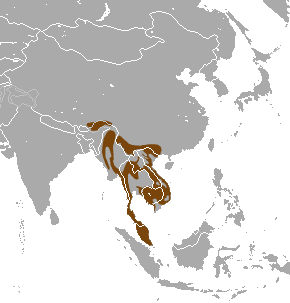Large-spotted civet facts for kids
Quick facts for kids Large-spotted civet |
|
|---|---|
 |
|
| Drawing dated 1884 | |
| Conservation status | |
| Scientific classification | |
| Genus: |
Viverra
|
| Species: |
megaspila
|
 |
|
| Large-spotted civet range | |
The large-spotted civet (Viverra megaspila) is a type of animal called a viverrid. It lives in Southeast Asia. Sadly, it is listed as Endangered on the IUCN Red List, which means its numbers are very low and it's at risk of disappearing.
What Does It Look Like?
The large-spotted civet can be many colors, from silvery-grey to golden-brown. It has a pattern of black or brown spots. These spots can be large or small, and sometimes they join together to form bigger patches or even stripes behind its shoulders. Its tail has white bands, but these usually only appear on the sides and bottom, rarely forming full rings around the tail.
Adult large-spotted civets are about 30–30.5 in (76–77 cm) long from head to body. Their tails add another 13–15.5 in (33–39 cm) to their length. They usually weigh between 14.5–18.5 lb (6.6–8.4 kg).
Where Do They Live?
Large-spotted civets can be found in several countries in Southeast Asia. These include Myanmar, Thailand, Malaysia, Cambodia, Laos, Vietnam, and southern China. In China, the last time one was seen was in 1998.
These civets like to live in different kinds of forests. They can be found in evergreen forests, deciduous forests (where trees lose their leaves), and dry dipterocarp forests. They usually live in areas below 300 m (980 ft) in height. In Thailand, you can find them in several protected areas, as far south as Ranong Province.
What Do They Do?
Scientists don't know much about what large-spotted civets eat or how they behave in the wild. More research is needed to understand their daily lives.
Why Are They in Danger?
The large-spotted civet is in danger for a few reasons. One big problem is habitat degradation and habitat loss. This means their forest homes are being damaged or completely destroyed. They are also hunted by people using traps and dogs.
Their numbers are shrinking steadily across all the countries where they live. In China and Vietnam, their populations may have dropped a lot. Sometimes, these civets are hunted for food in markets in China and Vietnam.


